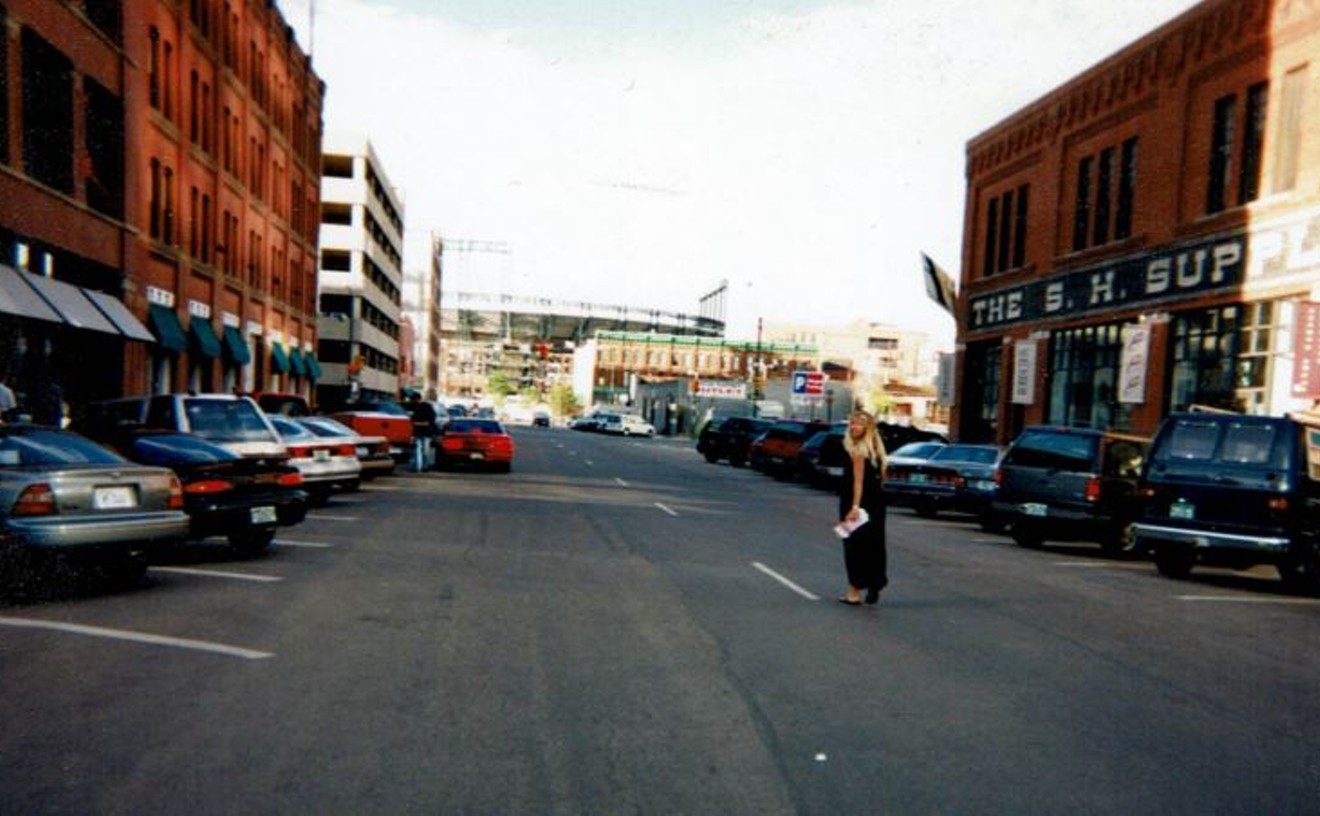When I started looking for obscure historical monuments, sites and artifacts across Colorado — rather than the celebrated, well-known tourist attractions around the state — I thought I'd find maybe ten worth sharing. Now my list is up to 200 and counting, as I keep finding odd, fascinating pieces of our past strewn under our feet. I've already shared ten of the weirdest monuments around Colorado; here are ten
more:
1. Columbine Mine Massacre rest area and memorial
State Highway 7 (Baseline Road), ¼ mile southwest of Sheridan Boulevard intersection, Lafayette
The company town was named, ironically, Serene. It held the miners who worked the Columbine coal mine, approximately one and half miles northwest of this site, and became an armed camp. On November 21, 1927, 500 radical Industrial Workers of the World-affiliated miners and their families had been on strike for five weeks. For two weeks, they had held daily morning rallies outside the camp gates. That morning, they were greeted by plainclothes former Colorado Rangers toting rifles, as well as mine guards with tear gas and machine guns. The miners fought to enter, and the armed men fired, killing six and wounding 23. None of the assailants were arrested or indicted. The miners got their union contract, but through the more pliable United Mine Workers of America, not the IWW.
2. Katherine Anne Porter’s brush with death
John Hand Building, 1510 York Street
A simple rectangular plaque used to adorn the second-floor hallway of the building at 1510 York Street, commemorating the near-death experience that stellar novelist and short-story writer Katherine Anne Porter experienced when the address was a rooming house. Porter lived here for a year beginning in May 1918, working as a journalist for the Rocky Mountain News (a job she hated). Swept in the great influenza pandemic in early October of that year, she was so close to death that they wrote up her obituary at work. She ran a fever of 105 for nine days straight. She survived, losing all of her hair for a time until it grew back, dead white. Her first big success, "Pale Horse, Pale Rider," is a fictionalized version of the event she termed a dividing point in her life, one that gave her a “beatific vision” and changed her forever. I last saw the plaque in the early 1990s; it’s not there now. Has anyone seen it?
3. Columbus Statue
Civic Center Park
Colorado was the first state to celebrate Columbus Day, in 1906, thanks to the Italian-American community of Pueblo. This symbolic statue in honor of the Italian explorer was installed in 1970, a schematic four-armed, four-faced figure boxing the compass inside a celestial globe. Its sculptor, William Joseph, also created the Bronze Fountain that stands at 19th and Welton streets. It wasn’t long after, though, that historians and native activists began to recast Columbus as an oppressor, exploiter, enslaver and perpetrator of genocide. In 1989, American Indian Movement activist Russell Means and others threw fake blood on the statue during violent protests. Means was arrested, then acquitted on free-speech grounds. Now the statue stands, little noticed, a relic of an earlier and discredited version of history.
4. Cement Bill’s rock
Buffalo Bill Grave & Museum, 987 Lookout Mountain Road, Golden
William Williams was a Golden cement contractor. When he heard that a mountain parks system was being planned, he decided a road was needed to the top of Lookout Mountain. So he surveyed the route, designed it and built it himself between 1910 and 1914, primarily with his own money. (He also built what became U.S. 40, through Floyd Hill up to Idaho Springs.) The resulting Lariat Trail, now Lookout Mountain Road, was a huge tourist attraction, and Colorado, Jefferson County and Denver promised to pay Bill back. Denver kept putting him off, and in May 1914, he blocked the road and refused to let anyone with a Denver license plate use it. The city paid up. A real do-it-yourself kind of guy, Bill built this monument to his labor in the parking lot.
5. ‘Red’ Barker’s plaque
3800 block of West 73rd Avenue, Westminster
He was the only member of “Ma” Barker’s gang to go straight. While his mother and brothers fought J. Edgar Hoover and the law to their deaths, Lloyd “Red” Barker served time in Leavenworth Prison, from 1922 through 1938. Paroled, he served in the Army during World War II; he later got married, settled in Westminster, and became the assistant manager of Denargo Grill at 29th and Broadway. On March 18, 1949, at 7 a.m., he was unlocking the back-porch door of his house at 3246 West 73rd Avenue, coming home from work as he always did, when his wife Jean killed him with a shotgun blast. She was committed to the Colorado State Insane Asylum in Pueblo for life. There's a plaque memorializing his life on the north side of 73rd.
6. The Whiskey Hole
Tarryall Diggings site, two miles west of Hight 285 and Tarryall Creek, one mile northeast of Como
The Tarryall site in South Park was one of the first boom towns of the Colorado Gold Rush. The pickings were so good that newcomers thought the claim owners were too greedy, rechristening the town “Grab All,” then moving away and founding, in deliberate contrast, the town of Fairplay. However, the founding fathers of Tarryall were kind. They set aside a promising placer claim and let bankrupt miners pan it for drinking money, a bit of socialist DIY uncommon at the time. Not even ruins remain of Tarryall now, but the played-out gulch still sits up the old road, abandoned and overgrown. A memorial at Highway 285 and Tarryall Creek tells Tarryall’s story.
7. James Brown Soul Center of the Universe Bridge
13th Street and Shield Drive, Steamboat Springs
When this mighty span was flung across the Yampa in 1993, replacing an old stockman’s bridge, it was nameless. The city took suggestions, a vote was held, and somehow this name won. On September 15, 1993, the Godfather of Soul himself, with an entourage of fifteen, dedicated the bridge in front of a crowd of 2,000.
8. The Tower of Memories
8500 West 29th Avenue, Lakewood
The Olingers opened their 180-acre Crown Hill cemetery in 1907, straddling the borders of Lakewood and Wheat Ridge. The seven-story mausoleum in its center was begun as a Gothic structure in 1926, then completed 22 years later in a Modernist style. The brightly lit spire looms on the ridge top, visible from miles around. We long speculated that it was a vampire’s lair or a disguised missile site. A personal visit reveals only three vast, ice-cold floors filled with burial chambers. The upper floors have been sealed off. In 1987, the building was listed on the National Register of Historic Places.
9. The saber-toothed tiger donation box
Denver Museum of Nature & Science
2001 Colorado Boulevard
This cute little fundraising statuette has stood in the lobby of the museum for 43 years, responding with an electric yowl when spare change is fed into his mouth. (Long ago, when it was still the Denver Museum of Natural History, admission was free and donations were encouraged.) The bust was created by Henry Wichers Inchumuk and Richard Stucky at the museum, taken from molds of the bones of an extinct Smilodon. The fourth generation of my family recently fed the tiger, laughing as their coins made him roar.
10. Winfield Scott Stratton statues
Nevada and Pikes Peak Avenues, Colorado Springs; Myron Stratton Home, 2525 Colorado Highway 115, Colorado Springs; Cripple Creek District Museum, 510 Bennet Drive, Cripple Creek
Winfield Scott Stratton was one of history’s nice guys. A carpenter whose work can still be seen adorning some of the vintage homes in Colorado Springs, Stratton prospected relentlessly for years until he hit pay dirt at the Independence claim near Cripple Creek in 1891 – one of the largest gold strikes in American history. The overnight multi-millionaire proceeded to give millions away – donating acres of prime real estate to the city, building a streetcar line, funding the relief for the victims of the devastating Cripple Creek fire of 1896 by himself. He helped down-and-out fellow prospectors, even giving former silver magnate Horace Tabor $15,000 when he went broke. After Stratton died, it turned out that he'd given most of his fortune to the establishment of the Myron Stratton Home to benefit low-income children and the elderly. This triggered years of litigation from angry relatives and fortune hunters, including thirteen women who claimed to have been secretly married to him. The Home still stands, however, still fulfilling its mission. Stratton's exemplary kindness was a rarity and is justly honored.
[
{
"name": "Air - MediumRectangle - Inline Content - Mobile Display Size",
"component": "12017618",
"insertPoint": "2",
"requiredCountToDisplay": "2"
},{
"name": "Editor Picks",
"component": "17242653",
"insertPoint": "4",
"requiredCountToDisplay": "1"
},{
"name": "Inline Links",
"component": "18838239",
"insertPoint": "8th",
"startingPoint": 8,
"requiredCountToDisplay": "7",
"maxInsertions": 25
},{
"name": "Air - MediumRectangle - Combo - Inline Content",
"component": "17261320",
"insertPoint": "8th",
"startingPoint": 8,
"requiredCountToDisplay": "7",
"maxInsertions": 25
},{
"name": "Inline Links",
"component": "18838239",
"insertPoint": "8th",
"startingPoint": 12,
"requiredCountToDisplay": "11",
"maxInsertions": 25
},{
"name": "Air - Leaderboard Tower - Combo - Inline Content",
"component": "17261321",
"insertPoint": "8th",
"startingPoint": 12,
"requiredCountToDisplay": "11",
"maxInsertions": 25
}
]











